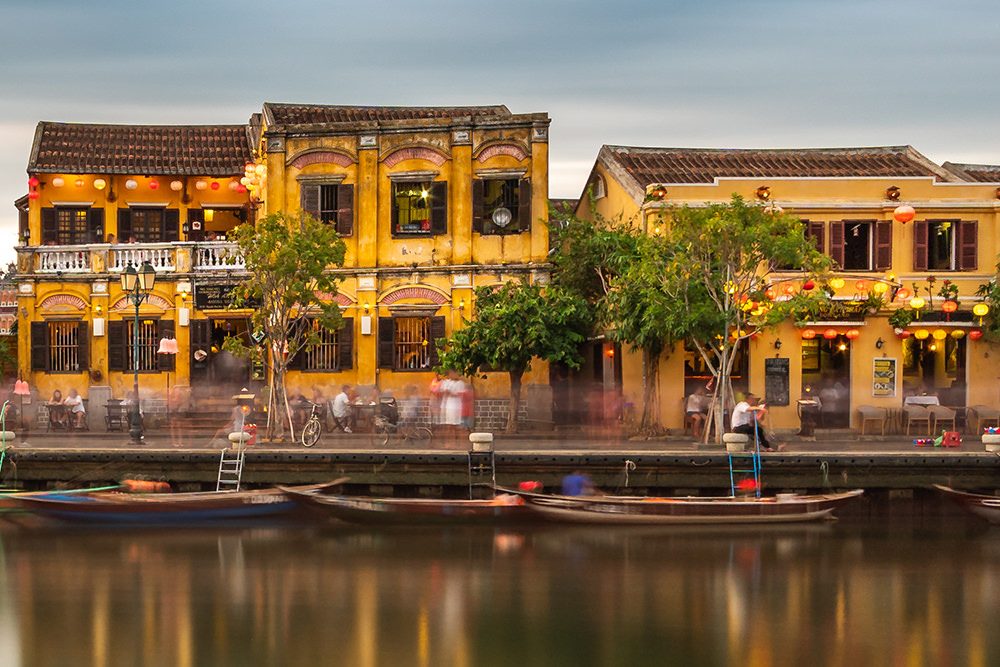
Hoi An is the most enjoyable place to travel in Vietnam, bar none. That might seem like a pretty bold claim, but I’ve talked to literally hundreds of travellers about their time in Vietnam during my decade of living here, and every single one of them who visited Hoi An loved it.
In this guide, I’ll go over all you need to know about Hoi An to take full advantage of the town’s charms during your Vietnam trip. From how to get there to what to do in Hoi An, where to stay, and how to get around in town, you’ll be able to explore the city like a local after reading.
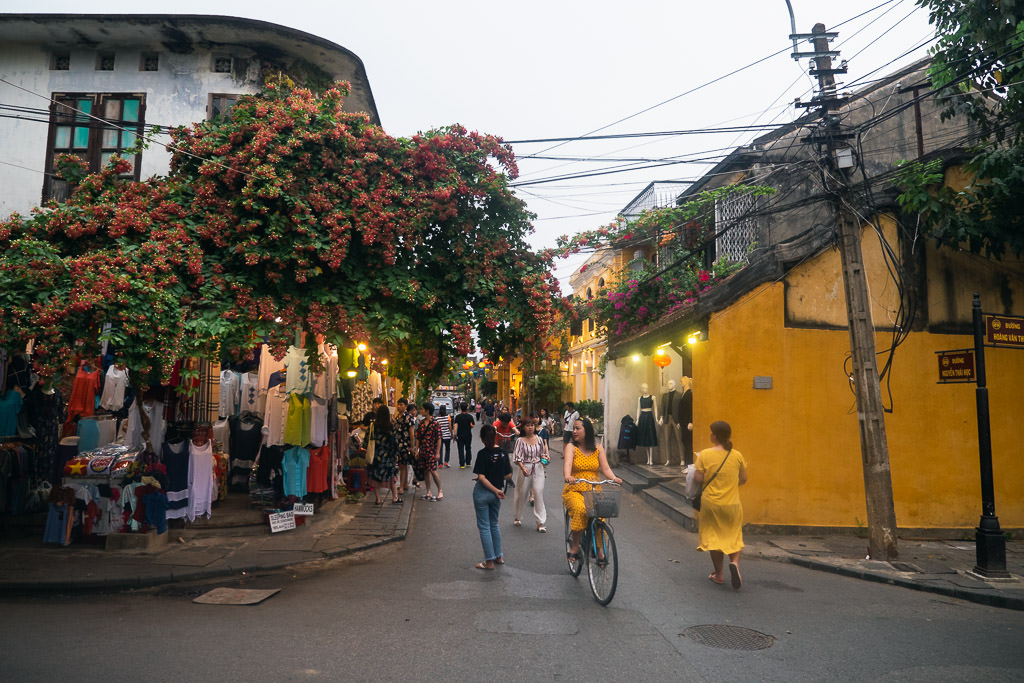
What makes Hoi An unique
Hoi An is the best example of a melting pot culture of any town in all of mainland Southeast Asia. It served as a major trading port during the 16th to 18th centuries.
During that time, it was an important hub for Japanese, Chinese, Portuguese, Dutch, and French traders in addition to the Vietnamese themselves.
Not only were goods exchanged between these cultures, but ideas about cuisine, architecture, and craftsmanship were, too. This exchange created a unique feel that is noticeable in many aspects of the town, including:
Architecture
Hoi An’s Old Town consists of cute low-rise houses with wood trimming and vibrant yellow paint jobs.
The houses are very unlike most Vietnamese architecture and look like a mashup of small-town buildings from a village in old China and a village in the Netherlands.
Most port towns in Asia were redeveloped with modern buildings during the past century, so their heritage was sadly lost.
Hoi An’s shophouses and old street grid remained intact, which is why it has received UNESCO World Heritage recognition.
 (iStock/Manel Vinuesa)
(iStock/Manel Vinuesa)
Sleepy aesthetic
The flower-lined cobblestone streets of the town create a quaint, sleepy aesthetic that very much feels like something out of a Miyazaki film (shout out to all my Studio Ghibli fans). The Thu Bon River running through town and the ornate footbridges spanning it add a lot to the ambiance, as well.

Accessible culture
Hoi An has so much culture that it’s bursting at the seams; it’s common to see artisans like calligraphers, traditional dancers, mask-makers, singers, or sculptors in front of shops practicing their craft.
Traditional symbols of Asian culture, like colored lanterns, dragon statues, and street vendors in conical hats, are all around you. You don’t have to go out of your way to experience cultural immersion in Hoi An.
No traffic
There’s no traffic on the streets of Hoi An’s Old Town, which is mainly a pedestrian area. It’s a very welcome break from other popular tourist spots in Vietnam.
Food
For such a small town, Hoi An is home to a surprising amount of distinct foods you’ll have a lot of trouble finding anywhere else, even in nearby cities or towns. You can explore the distinctive cuisine with cooking classes or a street food safari of your own – I’ll get more specific about both these activities in this guide’s “what to do in Hoi An” section.
How to get to Hoi An
The four best ways to get to Hoi An are:
By taxi
If you’re already in Da Nang, the best way to get to Hoi An is by taxi. The drive is only about 45 minutes, and the cost should be 250k-300k VND (about $10-12).
MAKE SURE to agree on the fare before you get in the taxi! It’s an important precaution to avoid scams. If the driver tries to convince you that 300k is an unreasonable price, simply stand your ground and leave to find another taxi if he won’t budge.
By bus
Vietnam has a really great cross-country bus system. The buses are comfortable, with AC and reclining seats that allow you to lie down fully. They’re also safe, thanks to Vietnam’s well-maintained highways and roads. It doesn’t hurt that they’re extremely affordable, too.
Since Hoi An is such a popular tourist spot, there are buses going from every major city directly to Hoi An. I’d recommend 12go.com for booking bus tickets in Vietnam.
 Typical long-distance bus in Vietnam
Typical long-distance bus in Vietnam  I loved this VIP bus with full bed
I loved this VIP bus with full bed
The table below shows distance, time taken, and average price for a bus ticket from several Vietnamese cities.
By train
Vietnam has an excellent North-South train line, and the city of Da Nang is the nearest stop to Hoi An.
I’d highly recommend this method of travel if you’re in Vietnam and want to visit Hoi An, as Central Vietnam is the most scenic part of the country to travel on the train route.
In particular, the ride between Hue and Da Nang provides some mind-blowingly beautiful views from the Hai Van Pass.
Train tickets are easy to book online, with my recommended site for booking still being 12go.com. Travel times are similar to what they would be for the bus, and the price is about 1.5x times as high, but it’s a much more scenic and comfortable way to travel.
After taking the train to Da Nang, simply leave the station and book a car using the instructions provided above.
 (iStock/fivepointsix)
(iStock/fivepointsix)
Important: You can book trains in Vietnam directly with Vietnam Railways, but only using Vietnamese payment methods. For foreigners, it’s easiest to book with third-party sites like 12Go Asia or Baolao (which charge a 40,000 dong commission).
By plane
Da Nang International Airport is only 45 minutes from Hoi An’s old town.
It receives lots of flights from almost every airport in Vietnam and from nearby countries, so you can fly there whether it’s your first destination in Vietnam or an addition to a trip through the country. A few of the most popular flights to Da Nang are:
VietJet is the best budget option for flights to Da Nang, operating throughout most of Southeast Asia and Japan. Air Asia is another great budget airline to Vietnam, or Vietnam Airlines for a higher-end experience.
After flying into Da Nang, take a taxi from Da Nang to Hoi An using the directions in the taxi section above – it only costs 250-300k.
Where to stay in Hoi An (Hoi An neighborhood guide)
Hoi An has diverse neighborhoods for accommodation. A few of the most interesting are:
Old Town
Hoi An’s old town is the center of the action, with enough high-quality street merchants, cultural landmarks, charming cafes and eateries, and flower-lined alleyways crammed into a small space to keep you entertained for at least a week.
At night, the part of Old Town along the river even erupts into a night market with local artisans and performers making the streets feel even more alive than during the day.
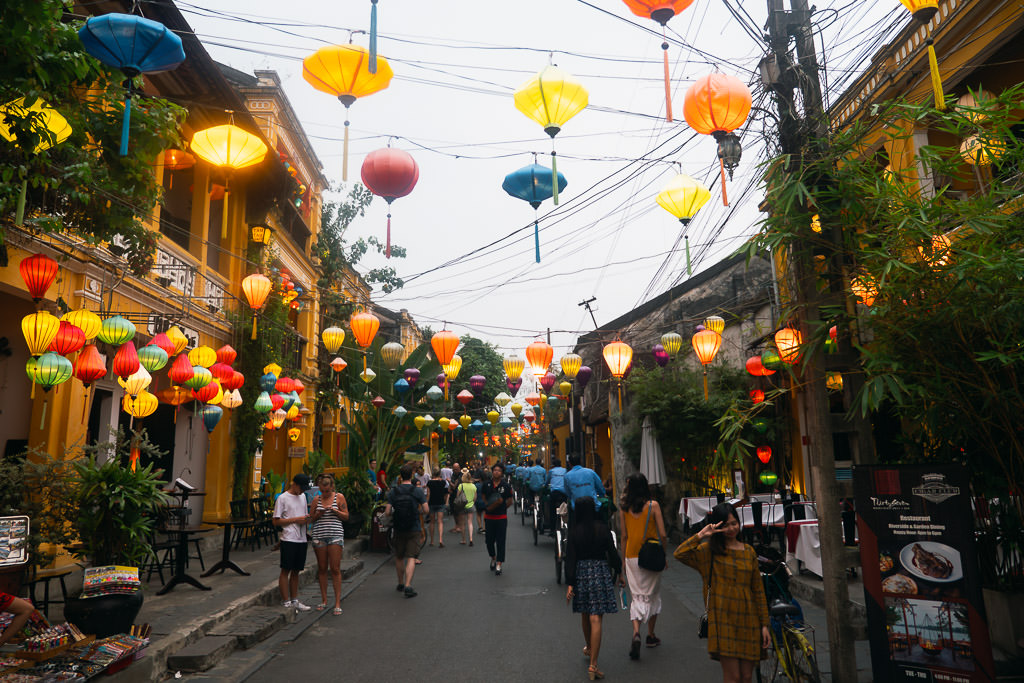
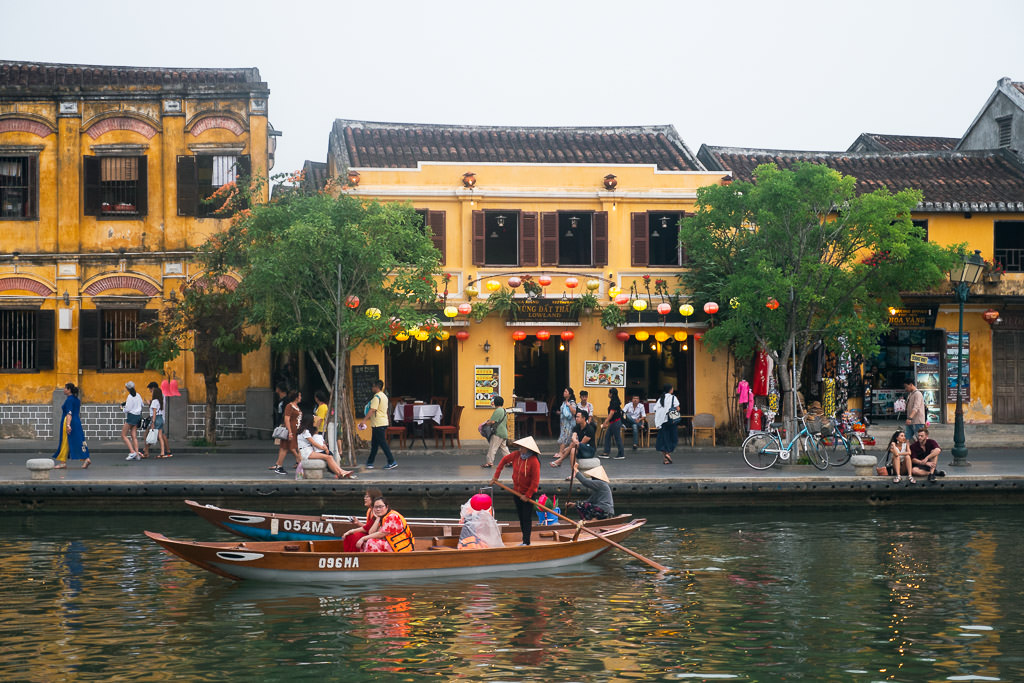

Essentially, Hoi An’s Old Town has everything you need to make your time in Hoi An feel magical. It is crowded with tourists, especially in the evenings, but that’s part of its charm; it feels bustling, alive, and vibrant.
Just a stone’s throw away from the center, the ancient town of Hoi An, and An Bang beach
Nestled in lush tropical gardens, just a short walk from Hoi An’s Ancient Town
Cam An
There’s so much to do in Hoi An that a lot of people don’t even realize it has some awesome beaches, too. I’ll talk about individual beaches more in this guide’s section on “what to do in Hoi An,” but the best neighborhood to stay for seaside vibes is Cam An, a peninsula that separates the ocean from the Thu Bon River.
Like Old Town, Cam An accommodations generally don’t have the rock-bottom prices you can find in some parts of Hoi An. It does have places ranging from mid-priced beach bungalows to luxury resorts, though.
A beachfront boutique stay—just a short walk from both An Bang and Cua Dai beaches
A minimalist beachfront retreat in Cam Lâm—just a 10-minute walk from Bai Dai Beach
Note: I’d discourage you from staying on Lac Long Quan, Au Co, or Cua Dai street itself, the three main streets on the peninsula. Getting just a block away makes for a much more peaceful stay.
An Hoi
Unlike the previous two neighborhoods, this island across the footbridges from Old Town has a lot of VERY inexpensive hotels. There’s a school on the island, so there’s a lot of affordable food and cafes for the students, too. The night market also centers here, so it has a bit of a carnival midway feel once the sun goes down.
The downside of the island is that it can feel a bit seedy. It’s dirtier than the rest of Hoi An, and lots of the businesses are massage places and pharmacies without the charm of Old Town.
Staying on An Hoi may be the best choice for travellers on a tight budget, though, and it’s only a two-minute walk from the gorgeous Old Town.
Cam Pho
Cam Pho is the area to the west of Old Town, and it has a much more authentic feel. Whereas Old Town is almost entirely a tourist haven, Cam Pho feels like an actual urban district where real people go about their business.
This area doesn’t really have any historical landmarks, but it does have a lot of nice restaurants and cafes. Plus, it’s only a few minutes walk to Old Town.
Cam Pho has some very inexpensive options that are still quite nice – my top pick is Melody Boutique Villa Hoi An, which has a comfortable and modern urban feel but is only $15/night! Other accommodation options in the area include:
Villa-style stay in the cultural area of Cam Pho with many art galleries
Cam Chau
One of the major appeals of Hoi An is how quickly you can get into the totally unspoilt Central Vietnamese countryside, complete with endless expanses of lush green rice paddies, narrow paths snaking through them, and enough peace and quiet to make even the most high-strung travellers feel relaxed after a few days.
The drawback of staying here is that the main town is on the other side of a long metal bridge that’s not pedestrian-friendly.
As long as you have your own bicycle or motorbike, though, or if you’re fine with taking a taxi, you can find some fairly inexpensive and incredibly picturesque country-style homestays in Cam Chau.
Quiet homestay, set back from the street, in a green and well-maintained setting
What to do in Hoi An
My top recommendations for activities during your time in Hoi An are:
1. Visit landmarks
You could spend a whole day strolling around Hoi An and viewing its many landmarks. The most memorable ones in my experience are:
- The Japanese Covered Bridge, perhaps the most impressive example of Japanese architecture in Hoi An.
- The Ancient House of Tam Ky, a shophouse that has been preserved to maintain the same interior setup by its original merchant owners.
- The Fujian Assembly Hall, a gated Chinese temple dedicated to the sea goddess that has some really ornate dragon sculptures.
- The army blockhouses near Hoi An Central Park, a must if you’re into wartime history.
 The Japanese Covered Bridge
The Japanese Covered Bridge  The Fujian Assembly Hall
The Fujian Assembly Hall
There are tons of others, especially when it comes to Chinese temples and pagodas.
Officially, you will need a ticket to walk around the Old Town. However, it’s only likely to be checked at the designated monuments. So if you are planning to visit them all, head for the small yellow ticket booths and pay the 120k admission. It comes with 5 small coupons that you can use at different sights, plus a helpful map, and proceeds go toward keeping the town in good shape.
2. Do crafts
Hoi An has a strong sense of community, and there are a lot of local crafts studios offering workshops teaching traditional Vietnamese artisan techniques. If that sounds interesting to you, you may want to check out:
Workshops like these have the bonus of letting you take home your completed work as a free souvenir!
3. Take a cooking class
Hoi An has a lot of cooking schools that will teach you to make local specialties. The tours take you around town to show you how ingredients are sourced, and a local chef guides you through the prep of a few dishes.
I can recommend the Hoi An Eco Cooking Class, the one I took a few years back. For $29, the tour takes you on a walking tour through the local market, on a basket boat ride through the coconut forest, crab fishing, and finally to an open-air kitchen where they teach you to make fresh spring rolls, crispy Viet pancakes, banana flower salad, and a grilled eggplant dish.
At the end, you get a cookbook so you can bring your newfound knowledge back to your kitchen at home.
book Hoi An Eco Cooking Class
Vietnam is one of the top coffee-producing countries in the world (second only to Brazil in global exports).
A coffee-making class is a great way to experience Vietnam’s rich coffee culture — and you’ll head home with unique brewing skills worth showing off.
4. Go on a riverboat ride
Riding basket boats in the coconut forest is a touristy activity advertised by a lot of local agencies, but I found it more scenic and relaxing to go on a Thu Bon River “cruise” departing from the footbridges area in the center of Hoi An Old Town.
Make sure to book a river boat that’s going far away from town, because the scenery starts to get really beautiful after you’re a few minutes away.
book this Thu Bon River Cruise 
You can book one of the boats yourself. The drivers generally speak English, and they charge for the entire boat – usually 150k for up to three people, and 200k for more than three.
The boats operate from 4:00 to 9:30 most days, and you should try to ride during sunset for some of the most beautiful vistas in the Hoi An area.
5. Go on a cycling tour
The rice fields surrounding Hoi An are some of the most gorgeous. The system of narrow roads running through them is amazing, too, since they’re clean and well-kept but still have a distinctly rural vibe.
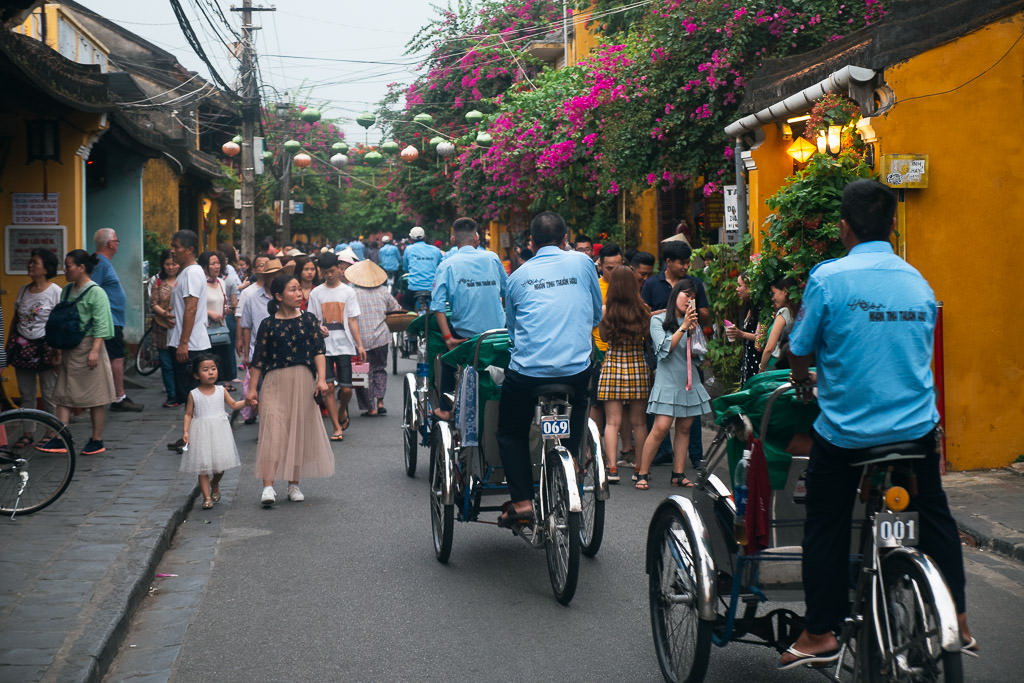 Long convoys of tour bicycles in Hoi An
Long convoys of tour bicycles in Hoi An
They’re completely flat and are too narrow to accommodate cars, which makes them easy and safe to ride on. All these factors make rural Hoi An one of the best areas in Vietnam for a cycling trip that people of all ages and skill levels can handle.
Heaven and Earth offer an evening cycling tour of the area for 29 USD that I really enjoyed.
6. Ride a water buffalo
The water buffalo is the national animal of Vietnam, so it’s practically mandatory that you get in touch with this gentle giant of a creature when visiting. And in the pristine farms surrounding Hoi An is one of the only places in the country where you can still do so.
I loved my water buffalo riding experience. I did it as part of a basket boat tour, but riding the buffalo was the highlight. They’re pretty shy for such imposing-looking animals, and it took some coaxing to get him to move once I was on, but riding through the swampy rice paddies once I did was unforgettable.
To book a water buffalo ride, ask at your hotel or head to Tra Que vegetable village and inquire at one of the hostels there. I’ve heard individual farmers will rent their buffalo for rides for only 30–40k.
book a water buffalo ride
7. Visit nearby artisan villages
Hoi An’s main town is surrounded by a few rural districts that specialize in certain types of wares, a really cool town structure that I’ve only seen in Northern Vietnam (Hanoi has this too). The specialized “villages” around Hoi An are:
- Tra Que Vegetable Village, an area of vegetable fields, quaint houses, and small restaurants serving the freshest-tasting vegetables I’ve had in my entire life.
- Thanh Ha Pottery Village, an ancient village where traditional pottery techniques have been preserved. You can watch potters at work here.
- Kim Bong Carpentry Village, the woodworking hub of the area. The village is located on a serene island accessible only by boat.
- Hoi An Silk Village, an area in the main town where you can watch every step of the silk-making process from silk worm cultivation to weaving.
Like the goods in Old Town, all of the products you’ll find in the artisan villages around Hoi An are of solid quality. They’re some of the best places in the country to shop for souvenirs.
8. Go on a street food excursion
As I mentioned, the amount of unique foods in Hoi An is amazing given that it’s not very large. That’s why I’d urge you to take an evening to fill up on street food.
Just take 300k, hit the Central Market, and buy whatever appeals to you. Keep an eye out for Hoi An specialties like:
- Cao Lau, a chewy noodle dish with a smoky taste
- Banh Bao Banh Vac, also known as “white rose dumplings”, are flower-shaped dumplings with minced shrimp or pork, crispy shallots, and an incredibly tangy dipping sauce
- Xi Ma, a black sesame sweet soup with a pudding-like texture

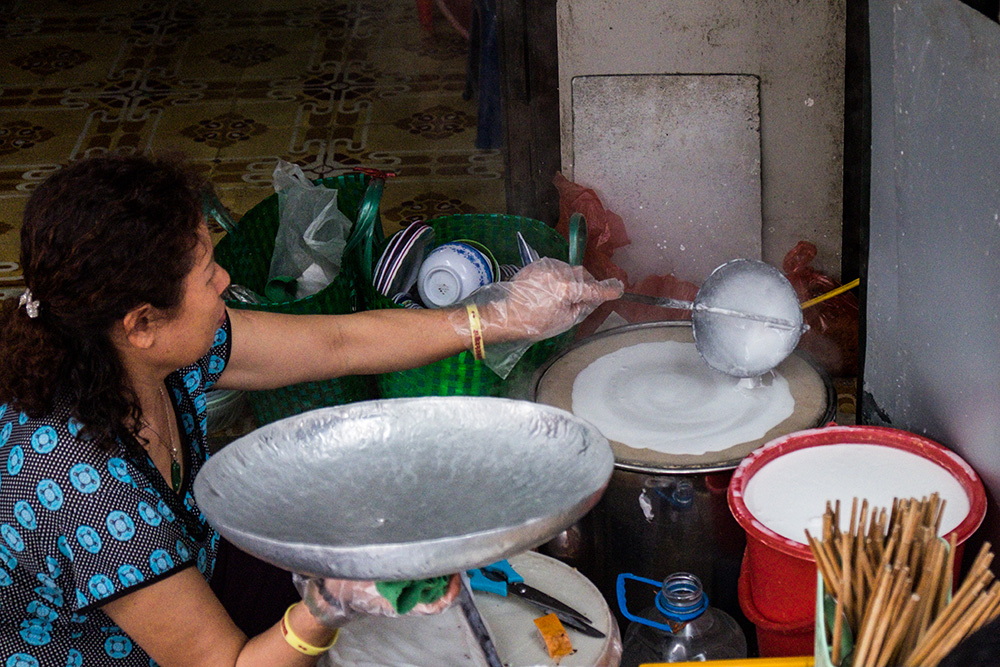
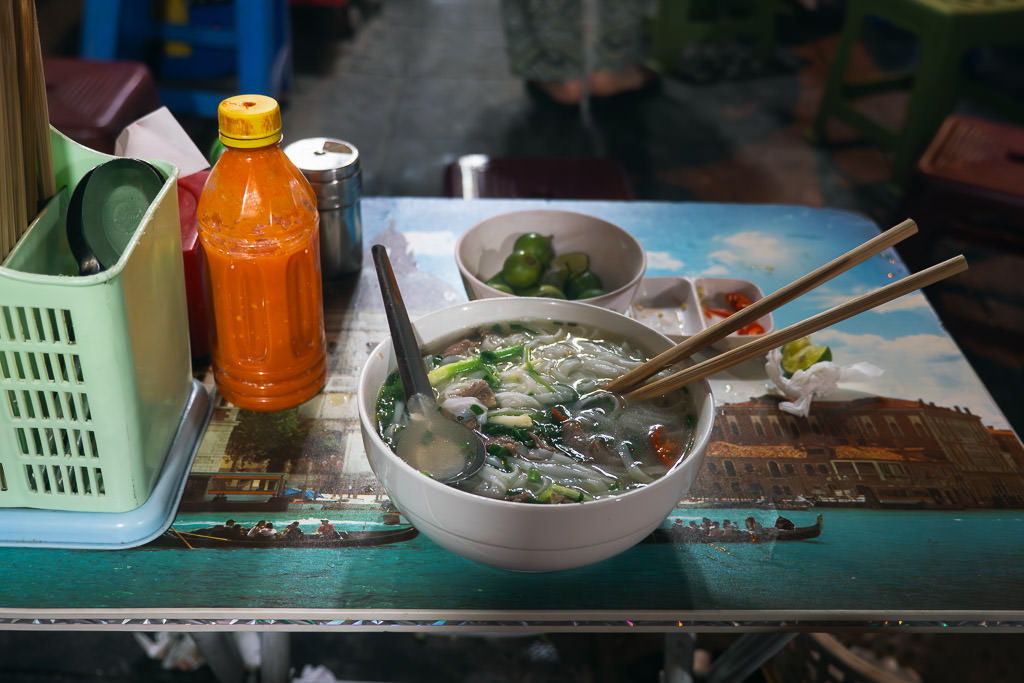
Great food — and plenty of it. You’ll definitely want to show up hungry! This evening food tour starts in the quieter part of New Hoi An and winds its way toward the Old Town, with stops along the way for some incredible local specialties.
Along the way, try the famous White Rose dumplings, sample Phi Bun Mi’s legendary chicken and egg sandwiches, and finish with a strong Vietnamese coffee.
book this tour for $39
9. Go to the beach
As mentioned in this guide’s accommodations section, Hoi An is also close to some great beaches. My favorite ones are:
- Coconut Beach – My favorite beach in Hoi An, because its white sands are completely pristine, but it’s almost always empty. I think it might be because the beach is in front of a big resort and people think it’s private, but it’s not.
- An Bang Beach – The most touristy beach in Hoi An, but justifiably so. It’s clean, the swimming is great, and there’s plenty of space. Plus, it has tons of services like loungers on the beach you can rent, dozens of seafood restaurants on the sand, watersports to partake in, and bathrooms.
- Binh Minh Beach is a 30-minute drive south of Hoi An, but it’s worth it for the serenity you find there. The beach is huge and unspoilt, and it’s the best place to watch sunrises or sunsets from land in the area.

Cua Dai and Hidden Beach get a ton of media attention, but I wouldn’t recommend them. They’re both way over-touristed and have construction going on.
10. Browse the Precious Heritage Art Museum
Just west of Hoi An’s Old Town is the Precious Heritage Art Museum, where you can view photographs, traditional costumes, and cultural artifacts profiling Hoi An’s history.
The museum was established in 2017, so it’s nice and modern (something that can’t be said for most of the museums in Vietnam). It’s a fantastic way to soak up some local culture. As a plus, the museum entrance is free.
Hoi An day trips
Another major plus of Hoi An is its location near many day trip destinations like:
My Son Sanctuary (pronounced “Mee-Sun”)
My Son Sanctuary is the premier ruined temple complex in Vietnam. I prefer Thap Cham in Southern Vietnam because of its size, but My Son is definitely more popular.

There’s a tragic story behind the ruins: the Champa Empire built a lavish group of Hindu temples there between the 4th and 14th centuries, but they were bombed by the US during the war, and the priceless landmarks were irreparably damaged. Today, My Son is like a much smaller version of Cambodia’s Angkor Wat.
The ruins are part of a tourist area with a 150k admission, which also includes entrance to My Son Museum. Entrance is available until 5 pm.
Marble Mountains
The marble mountains are a cluster of five mountains named after the five elements. They’re between Hoi An and Da Nang, so they make a good stop between the two cities.
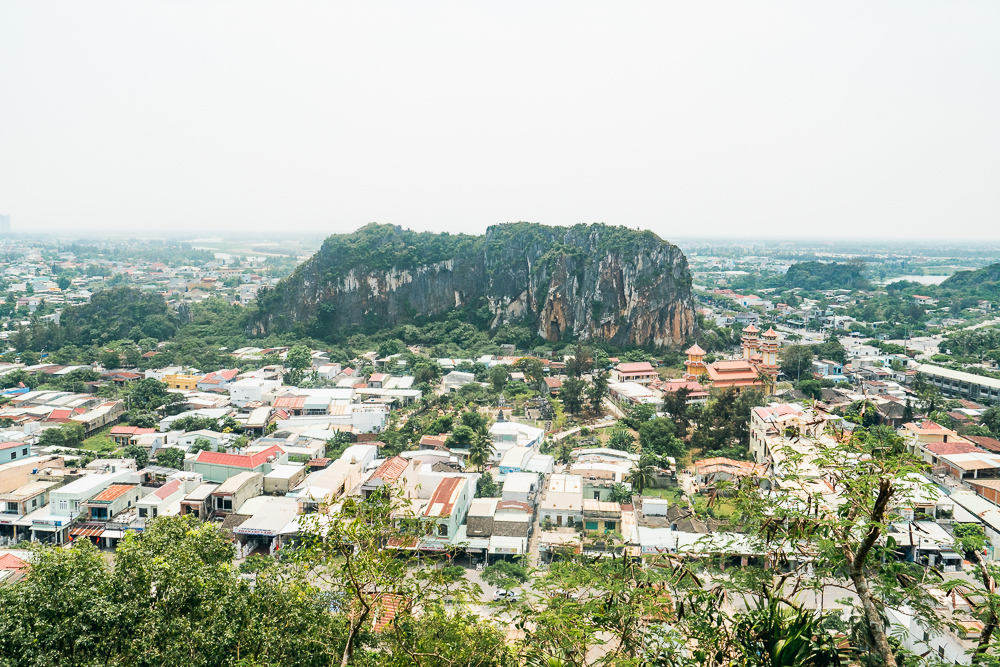
The mountains are amazing places to hike and take in some great vistas of the area. They’re filled with cave systems underneath the hiking trails, and some of the caves have Buddhist shrines or wartime encampments in them.
Entrance to the mountains is 40k per adult, an additional 10k if you want to use the elevator instead of climbing the mountain, and a further 50k if you want an English-speaking tour guide to show you around. There’s also a large cave at the foot of the mountains with an additional 20k entrance fee.
Marble Mountains is like a mini-park — you can easily spend an hour or two wandering winding paths, ducking into hidden caves, and spotting ancient pagodas tucked into the hills.
This organized trip from Hoi An to the Marble Mountains combines this natural wonder with other nearby highlights like the towering Lady Buddha statue and the mysterious Am Phu Cave.
Cham Islands
To enjoy a true island paradise near Hoi An, go to the Cham Islands about 13km off the Eastern coast.
The beaches are nicer than almost anything you’ll find on the mainland, and the islands house some gorgeous fishing villages.
If you want to go without a tour, a ferry leaves Cua Dai Harbor daily at 8 am and costs 350k for a round-trip ticket.
The return journey is at 11:20 am. If you need to go later, a speedboat leaves at 8:30 am and 1 pm. Prices vary for the speedboat, as does the return time.
Check out this boat tour on viator 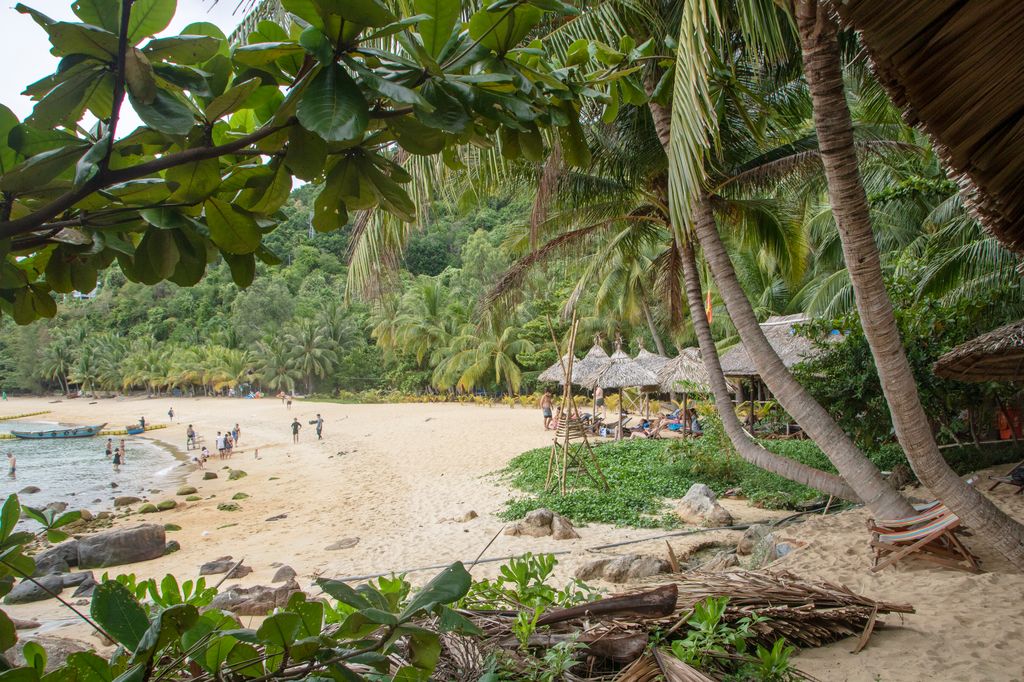
How to get around Hoi An
The best way to get around in Hoi An is by renting your own motorbike or bicycle. It’s a small town, so riding around is easy. Almost all hotels and travel agencies in Hoi An have bike rentals available.
If you would rather get around effortlessly, the Grab ride-hailing app also works well in Hoi An. Both car and motorbike taxi options are available, and it’s very affordable.
 (xuanhuongho/depositphotos.com)
(xuanhuongho/depositphotos.com)
Lastly, Hoi An is perhaps the most walkable city in Vietnam. Walking, of course, takes a bit longer and it’s really no fun to be walking during the midday heat in most months of the year, but it’s also a good way to immerse yourself in the local culture
When to visit Hoi An
I recently published a detailed guide on when to visit Vietnam. For info about when to visit Hoi An, check out the section on Central Vietnam.
Please visit:
Our Sponsor
